Brian Meert's Blog, page 103
October 30, 2018
Cruz vs O’Rourke: Using Facebook Ads to Predict Election Outcome
 October 30, 2018
October 30, 2018Anne Felicitas, editor at AdvertiseMint, Facebook advertising agency
 Ads run by Ted Cruz
Ads run by Ted CruzCan Facebook influence an election? It depends on you who ask.
If you ask former president Barack Obama, he might say yes. After Donald Trump won the presidency, nine days after Mark Zuckerberg dismissed the idea that fake news on his platform influenced the election, Obama, who believed the strong impact of fake news, advised the young CEO to assuage the spread of false news on his social media network. If you ask Max Read, a New York Magazine journalist, if Facebook can influence an election, he too would agree, citing misinformation’s effect on voters’ perspectives.
Of course, no one can know for certain whether Facebook alone can change the outcome of the election. Other strategic choices, such as campaigning at the right states and using the right polling data, can affect a candidate’s success. Nevertheless, campaigning is an important part of winning a political position, and where and how you campaign adds an even heavier weight on the outcome.
For Read, and maybe for Obama, fake news helped Trump win the presidency. But can Facebook ads, particularly, influence an election? Can it propel candidates to their coveted political positions? For the purpose of this experiment, let’s say it could. Let’s assume Facebook ads alone could affect election results.
In this experiment, I’m predicting the next senator of Texas by analyzing the October Facebook ad campaigns of the candidates Ted Cruz and Beto O’Rourke. The candidate with the highest-rated political campaign will be the predicted winner. I’ll rate, from a score of one to five, their campaigns according to the following criteria: spend, variety of ad creatives, media, ad copy, variety of ad formats, and clear objectives.
Spend
 O’Rourke’s total ad spend
O’Rourke’s total ad spend Cruz’s total ad spend
Cruz’s total ad spendThe higher the spend, the better campaigns will perform for several reasons. One, the higher the budget, the more resources available to A/B test ads. A/B testing is an important part of advertising because it allows the candidates to run the best performing ads, which cost less. Second, Facebook advertising is an auction in which the candidates must bid higher than their competitors’ to win a spot on Facebook’s feed. Third, a bigger budget allows them to scale campaigns.
O’Rourke is spending significantly more than his Republican opponent, Cruz, likely because Cruz is investing heavily on other platforms, like TV or radio. But I’m not here to judge other platforms. I’m here to judge Facebook ads.
Since O’Rourke has a budget large enough to A/B test constantly, bid higher in auctions, and scale campaigns, he receives a five out of five. Although Cruz has a lower score, a six-figure budget is ideal for a serious campaign. I also award him a five out of five.
O’Rourke: 5/5
Cruz: 5/5
Variety of Ad Creatives
Refreshing your creatives can significantly improve campaign performance. Refreshing ads every two weeks, as Facebook suggests, will keep the audience interested. Neglect to do so, and the audience will experience ad fatigue. To determine whether the candidates have good ad variety, I peeked into the number of ads they run to date. While O’Rourke runs 7,504 ads, Cruz runs 344. Cruz has a significantly smaller number of ads likely because of his smaller budget. As mentioned, the bigger the budget, the more resources to A/B test and scale, which both require creating new ads.
Scrolling through both candidate’s ad archives, I find O’Rourke has more ad variety. He runs ads of different formats, media, video sizes, and objectives. Some videos show him speaking in front of the camera, while others feature homemade square videos of supporters encouraging Americans to vote. Some ads feature interviews, while others feature images of his campaign volunteers. Cruz has less ad variety. Most of his campaigns are professionally edited horizontal videos and images, either featuring him or his opponent. Much of his creatives are similar with a slight copy or image variation.
 Cruz’s ads are mostly horizontal images and videos, with one or two square images.
Cruz’s ads are mostly horizontal images and videos, with one or two square images.
O’Rourke: 4/5
Cruz: 3/5
Media
Media occupies a significant part of ads and determine whether users will stop mid-scroll on their feeds. If using images, they must be crisp, clear, and attractive. If using videos, they must be short and vertical with subtitles underneath for sound-off viewers.
O’Rourke’s campaign consists of a few square videos and numerous horizontal videos, some with subtitles. O’Rourke has no vertical videos, a major disadvantage. Because the vertical format fills an entire phone screen, it’s ideal for attracting and arresting the attention of mobile users. O’Rourke’s videos are also longer than the recommended maximum of 30 seconds. The videos run from 44 seconds to one minute, not the recommended length. While some of his videos are reposts of news snippets and clips of him speaking directly to his audience, a large bulk of his videos are unedited, personalized videos by his supporters, lending a look of authenticity. This is advantageous to his campaign because most people on Facebook prefer amateur videos taken by regular users than professionally edited videos taken by an organization.
 O’Rourke’s ads feature supporters in horizontal videos.
O’Rourke’s ads feature supporters in horizontal videos.Ted Cruz, too, runs both video and image ads. Unlike O’Rourke, his video and image ads are all in the horizontal format (except for one vertical video ad), a format least recommended by advertisers. However, where Cruz fails, he makes up for his video length, which all follow the recommended 30-second maximum. Unfortunately, some of his videos don’t have captions, a major disadvantage, as most users watch videos with sound off. Cruz’s videos, reminiscent of a TV commercial, are all professionally edited, which may repel users.
 Many of Cruz’s ads feature O’Rourke
Many of Cruz’s ads feature O’Rourke
O’Rourke: 3/5
Cruz: 2/5
Ad Copy
Although the ad’s media receives the most attention, the copy should still be well crafted. Good copies are short, readable, complementary to the media, and concisely delivers the main message.
O’Rourke’s copies are mostly long, with no line breaks or emojis, making the ad appear unorganized, cumbersome, and messy. Because the copies are long, some readers may find the ad too wordy, too intimidating to read. Additionally, part of the message is truncated because the length is too long. Some of the copies have Spanish versions, allowing his message to reach the Spanish-speaking community.
 O’Rourke copies are long. Some have Spanish versions.
O’Rourke copies are long. Some have Spanish versions.Ted Cruz’s copies are short, taking up three to four lines. The copies also feature emojis to attract the eye and add visual appeal. The line breaks separate paragraphs, making the copy look readable, clean, and well-organized. Some of the ad copies also have Spanish variations to appeal to the Spanish-speaking community.
 Ted Cruz’s copies are short
Ted Cruz’s copies are short
O’Rourke: 2/5
Cruz: 5/5
Variety of Ad Formats
Using different ad formats reduces ad fatigue. Although image and video ads are the most used formats, other formats exist, such as Instant Experience, Carousel, and Slideshow.
O’Rourke’s campaign consists of images and videos, with few carousel ads. Cruz’s campaign consists of image ads, video ads, and one carousel ad. Both candidates don’t have a large variety of ad formats. However, O’Rourke has more advantage over Cruz because his video ads are a combination of square and horizontal while Cruz only has horizontal videos, save one or two square videos.
O’Rourke: 2/5
Cruz: 1/5
Clear Objectives
A campaign can’t perform well if it doesn’t have a clear objective. Before these candidates can start a campaign on Facebook, they must first clearly understand their campaign goals. Do they want to increase donations? Do they want supporters to understand their stances or do they want them to join a local event? The objective dictates which ad format to use and appears in the copy, the media, and the call-to-action button.
O’Rourke’s October campaign focuses on raising awareness, encouraging people to vote, increasing donations, and increasing event turnouts. To achieve these goals, the candidate runs a few videos ads of himself, briefly discussing his stances on political issues. Those videos are accompanied by long copies that summarize the message of the video. He also runs video ads featuring celebrities and supporters encouraging people to vote. Along with his video ads, he also runs image ads that encourage supports to donate and join events. Those ads contain the appropriate CTA buttons, “view event” and “donate now.”
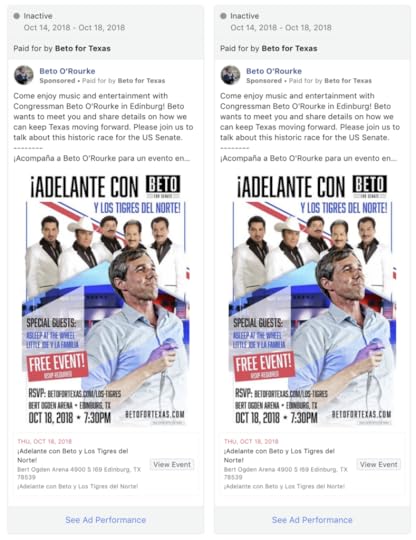 O’Rourke matches event objective with “view event” CTA.
O’Rourke matches event objective with “view event” CTA.In contrast, Cruz’s campaign, although also focusing on awareness, concentrates on donations. To raise awareness, he runs image ads featuring himself, his name, and his opponent’s stances on issues in the copy. He also runs video ads that center on O’Rourke, discussing his stances while images of him appear on screen. Unlike O’Rourke, Cruz spends no time speaking about himself and his beliefs and, instead, focuses on his opponent, O’Rourke. To increase donations, Cruz runs image ads featuring his portrait, short copies, and a “learn more” CTA, an odd choice compared to O’Rourke’s “donate now” CTA. Cruz’s objectives are not as clear as his opponent’s, since, instead of raising awareness on himself, he raises awareness on his opponents. Instead of giving a clear CTA for donations, he uses a “learn more” CTA that is better suited for an awareness ad.
 Cruz matches donation ads with “learn more” CTA.
Cruz matches donation ads with “learn more” CTA.
O’Rourke: 4/5
Cruz: 2/5
And the Winner Is…
Here’s a tally of each candidate’s score:
Spend
O’Rourke: 5/5
Cruz: 5/5
Variety of Ad Creatives
O’Rourke: 4/5
Cruz: 3/5
Media
O’Rourke: 3/5
Cruz: 2/5
Ad Copy
O’Rourke: 2/5
Cruz: 5/5
Variety of Ad Formats
O’Rourke: 2/5
Cruz: 1/5
Objectives
O’Rourke: 4/5
Cruz: 2/5 \
Total
O’Rourke: 20/30
Cruz: 17/30
O’Rourke wins by 3 points. Because his Facebook ad campaign bests Cruz’s, he is the predicted winner of this year’s election for the Senator of Texas.
Can Facebook Ads Influence an Election?
You may not be convinced that a social media platform can affect the outcome of elections. You may side with the critics who argue that to win elections, each candidate must make the right strategic choices, such as referencing the right polling data and campaigning at the right cities or states. You may also side with this research that asserts campaign outreach has zero effect on voters. No matter your stance, take this experiment with a grain of salt because it is simply that, an experiment. Also, recall that in this experiment, we assume that Facebook ads alone can affect elections outcomes. If results reveal Cruz to be the winner, you can dismiss this experiment as amateurish, akin to the World Cup predictions of Paul the Octopus. If O’Rourke emerges the winner, well, perhaps Facebook ads have at least a little bit of influence after all.
Written by Anne Felicitas, editor at AdvertiseMint, Facebook advertising agency
The post Cruz vs O’Rourke: Using Facebook Ads to Predict Election Outcome appeared first on AdvertiseMint.
October 25, 2018
20 Instagram Ads That Rock and Why
 October 26, 2018
October 26, 2018Anna Hubbel, writer at AdvertiseMint, Facebook advertising company

The popularity of Instagram advertising is booming as the platform’s user base continues to grow. In June, Instagram reached a major milestone of one billion monthly users. As a result, advertisers are flocking to Instagram to reach more people, particularly, the Gen Z generation. Using Instagram’s variety of selling tools, like Instagram’s Shopping tags, you can use the platform to acquire more sales for your business.
However, Instagram doesn’t do all the work for you. You need to exert your own creative elbow grease to generate the results you want through your Instagram campaign. But what makes a good Instagram ad? There are qualities that exceptional ads typically have. Usually, a great Instagram ad does at least a few of the following: educates, entertains, engages, provides a value proposition, provides social proof, evokes an emotion, has high-quality images or videos, features the product, and implements good branding. Finally, a good Instagram ad is optimized for mobile screens.
While imitation may be the sincerest form of flattery, we know there are some restrictions. For example, mimicking another brand’s social media and word for word, image for image, is an infringement on that brand’s intellectual property. If you want to refresh your ads with better creatives, you don’t need to copy word for word, image for image. Instead, you can get serious inspiration for your own unique ad by looking at ads other brands are showing off (for good reason). In this article, we’ll look at some examples of exceptional Instagram ads that will hopefully inspire you.
1. Shapermint
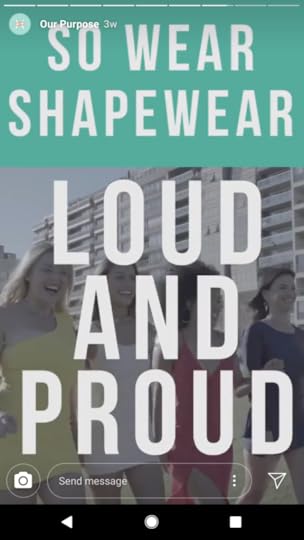
Shapermint is a brand that sells shapewear, clothing that slims women’s bodies. In this Stories ad, Shapermint uses a series of video clips and text overlays to show women of various shapes and sizes wearing Shapermint clothing with confidence. The ad promotes body confidence and pride, no matter the body shape or size.
In addition to using high-quality video, Shapermint uses large, bold text to get your attention and manipulate your emotion. The brand cleverly uses strong, empowering language, such as “We are more than just our bodies,” “Confidence,” “Comfortable in your skin,” and “In charge.” Using this kind of language, Shapermint inspires women, likening the purchase of its products to joining a social movement.
The ad also incorporates good branding throughout the video. Where there isn’t footage of women wearing the product, Shapermint uses text overlays with colored backgrounds that match the brand’s color scheme. Additionally, the ad is optimized well for mobile, dividing up the screen vertically where appropriate and filling up the vertical space.
2. Starbucks
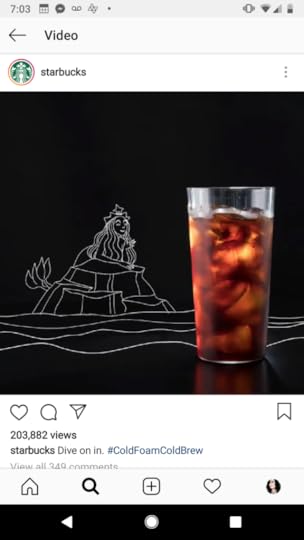
In this short Instagram video, Starbucks grabs your attention with a simple but effective animation. The mermaid dives into the ocean, splashing water into the pictured coffee drink, which foams at the top. The animation highlights Starbucks’ cold foam beverage with only a very brief caption: “Dive on in. #ColdFoamColdBrew.”
In addition to grabbing your attention right away and showing you the product it’s promoting very clearly, Starbucks also implements good branding in this animation. Specifically, the mermaid in the animation is the woman from the Starbucks logo, and the black background and chalk-like white lines match the aesthetic of a Starbucks cafe.
3. Mrs. Meyer’s Clean Day
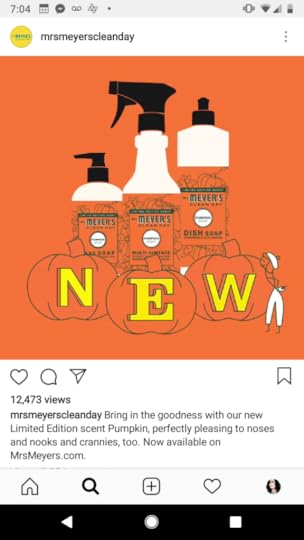
Mrs. Meyer’s Clean Day is a brand of household cleaning products. Relevance, color, and attention make this a great video ad. First, the video is relevant to the time of year, October, using the color orange and pumpkin carving typically associated with Halloween. Next, after the cartoon character carves the word “NEW” into the three pumpkins, Mrs. Meyer’s effectively grabs your attention when three of the brand’s cleaning products pop up from each of the pumpkins. The image fills the screen and shows you clearly the products the brand is marketing: limited edition, pumpkin-scented cleaning products.
4. Function of Beauty
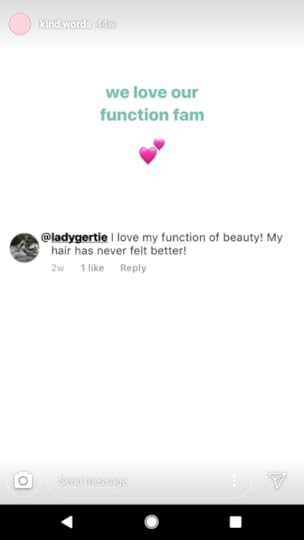
Function of Beauty sells customized shampoos and conditioners. This Stories ad is a great example of using social proof to build customer trust. Throughout the Kind Words story, Function of Beauty presents itself as a reputable brand by showing positive customer testimonials and online reviews of its products.
Customers are more likely to buy from a brand with a lot of positive reviews and testimonials. This ad creatively uses the Instagram Stories platform to get social proof of product reviews out there.
5. IHOP
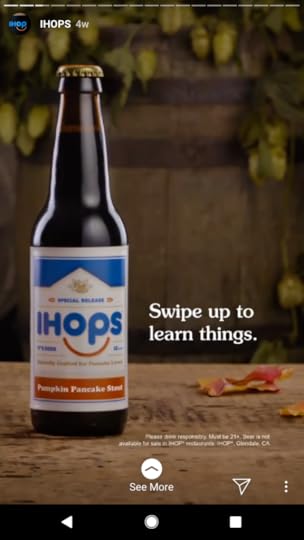
The International House of Pancakes (IHOP) offers more than just pancakes, as this Instagram Stories ad proves. This vertical ad implements the IHOP brand and humor throughout while also encouraging engagement. To promote its Pumpkin Pancake Stout, IHOP uses a series of close-ups of the beverage, as well as a video of the product being made. Periodically, IHOP presents call-to-actions, as seen in the image above with the “See More” swipe-up option, using humor to draw attention to it: “Swipe up to learn things.”
The series of Stories also include fall themes relevant to the season, such as a hand popping up from a pile of autumn leaves holding a bottle of the “Pancakin’ beer.” Additionally, IHOP throws in “I’m a pancake beer, ask me a question” bubbles to get its audience engaged.
6. Calvin Klein
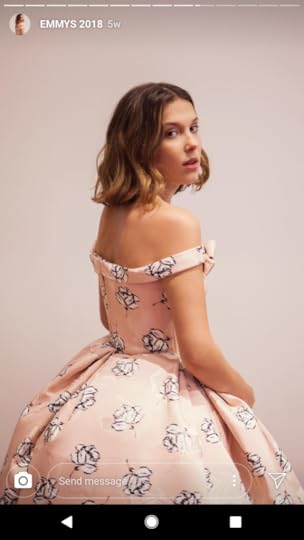
Calvin Klein is a sophisticated clothing and fashion brand, and we see that sophistication shine through in this Instagram Stories ad. The ad, titled “EMMY’S 2018,” goes behind the scenes in an “exclusive look” at the making of the brand’s custom Emmy looks. The video shows close-ups of sewing, pinning, and hemming of the dress in the image above. Once the dress is finished, Calvin Klein shows the model wearing it, zooming in on different parts of the dress. Watching this ad, you can’t help but feel both impressed and a little nostalgic.
The ad concludes with a close-up of the Calvin Klein label, leaving the brand name at the forefront of your mind.
7. Dove
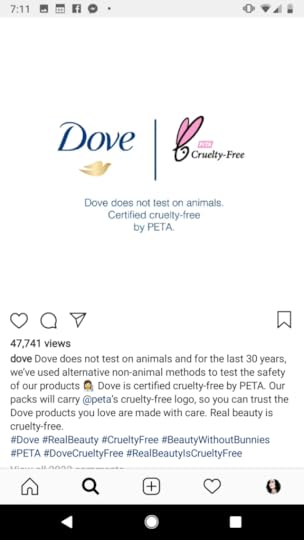
Dove uses clever branding by showing the classic Dove logo, but the dove under the name changes shape into different animals to get your attention, as well as to clearly convey the main message, which is Dove is cruelty-free. Next, the social proof comes in with the cruelty-free stamp by PETA. The approval by PETA tells you that Dove is an animal-loving brand that can be trusted.
8. WeddingWire
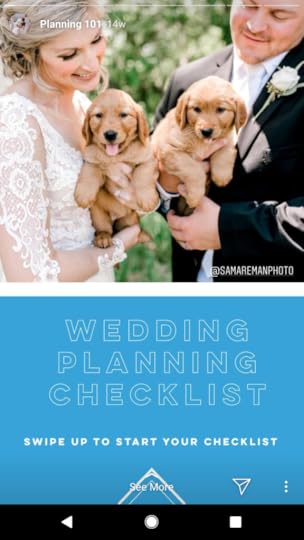
WeddingWire, a wedding planning business, engages with its audience in this mobile-optimized ad. It simply invites you to start your wedding planning list, keeping it relevant to what the business does (i.e. wedding planning) without pushing a sale.
The ad also appeals to our emotions. Who doesn’t love puppies? Combine puppies with weddings, the happiest days of people’s lives, and you can’t help but feel good looking at this ad.
9. Gap
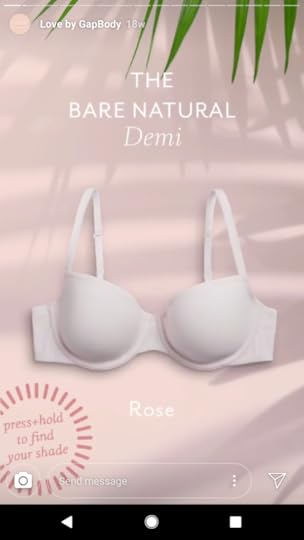
Gap, a long withstanding clothing retailer, uses this Instagram ad to feature its bra selection in different color variations, bringing the store window experience to your phone. As the bra colors change, you’re also encouraged to engage with the ad in the bottom left corner with a call to action that invites you to “press + hold to find your shade.” This call to action adds a personalized experience to get you interested and shopping.
10. Apple
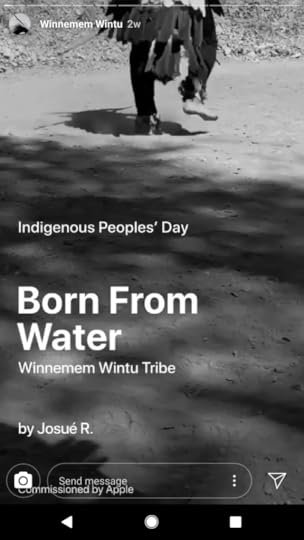
Although this Instagram Stories ad doesn’t feature any Apple products, it promotes itself by implying that the video was captured with an iPhone. It also uses an artistic black-and-white perspective associated with Apple’s image as an artsy technology brand.
The ad is socially relevant by recognizing Indigenous Peoples’ Day, highlighting the Winnemem Wintu tribe to establish the brand as culturally diverse. The “Born From Water” headline holds emotional weight, helping us appreciate the origins of the tribe.
11. Regal Cinemas

Regal Cinemas promotes its Regal Crown Club membership in this Stories ad. The mobile-optimized ad is simple, using a clip from a current movie shown at Regal theaters (Venom) to catch your attention. In addition to clearly headlining the ad with “Attention Regal Crown Club Members,” Regal attracts interest with the incentive to “save on your favorite candy all day!”. With the image of a hungry Venom, the ad is relevant both to the message and the movie-going experience of Regal Cinemas. The ad then caps off with a “see more” swipe-up call to action.
12. Ben & Jerry’s
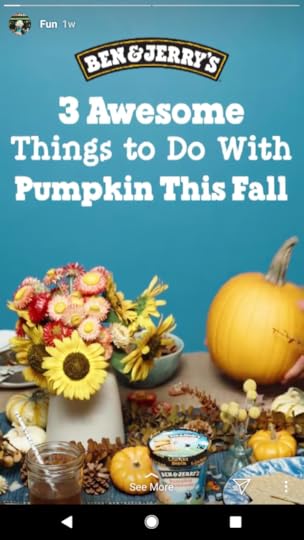
Ben & Jerry’s has no trouble promoting its ice cream even in the colder months. The brand uses seasonal relevance to engage its audience in this Instagram ad, making it more of an article headline than an ad promoting sales. It peaks your curiosity, inviting you to discover the three “Awesome Things to Do With Pumpkin This Fall” by swiping up on “see more.”
While the foreground includes autumn-related objects, such as pumpkins and leaves, the ad still incorporates branding. We see this with the subtle placement of the Ben & Jerry’s ice cream carton at the bottom, as well as the light blue background and Ben & Jerry’s logo at the top.
13. Stitch Fix
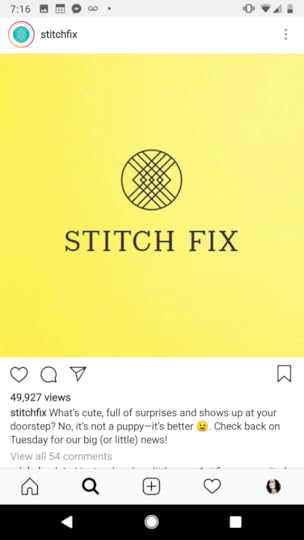
Stitch Fix, a subscription fashion brand that delivers personalized outfits to your doorstep, creates a little mystery and curiosity in this Instagram ad. In a 3-2-1 countdown video, Stitch Fix announces, “We’ve got some (little) news!” and concludes simply with the Stitch Fix logo. You’re left wondering what the news is, so you naturally look at the caption for an explanation. The caption tells you to “check back” to hear the “big (or little) news!” By drawing your attention to the caption and then saying you have to check back later to find the news, Stitch Fix is able to engage its audience and keep them returning for more.
14. Glade
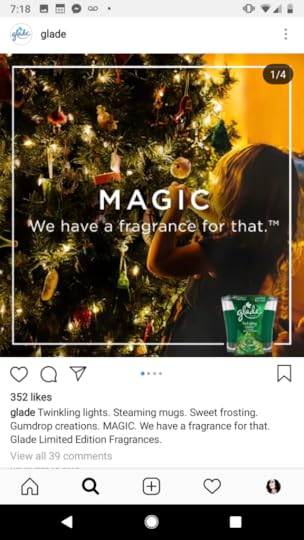
Glade, the fragrance brand, gets in the holiday spirit in this ad. The first image is a simple video animation: the lights on the tree twinkle while everything else is still. It’s an adorable image that appeals to your nostalgic and warm family feelings that come during the holidays. Glade plays up the sparkle of the image with a simple text overlay: “Magic: We have a fragrance for that,” as well as a caption that sets the holiday scene. The ad also includes subtle but effective branding with the small placement of a Glade candle in the bottom-right corner. You can almost smell Christmas trees and hot cocoa just looking at the image.
Swiping through the other images in the ad, you get more images paired with specific fragrances. For example, the second image shows a child with a cozy, warm beverage, and only the steam rising from the mug and the snow outside the window are moving. In the bottom right corner, we see a different Glade fragrance that fits the setting. The other two images follow the same pattern. Overall, branding and emotion are the qualities that stand out in this ad.
15. Yankee Candle
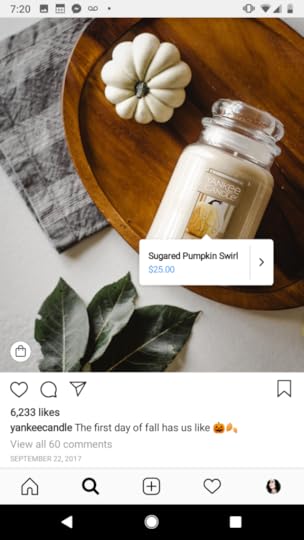
Yankee Candle gives us a perfect example of how to use Shoppable tags. The image is simple, showing a seasonal pumpkin candle in a professionally arranged photo. When you tap on the image, a tag pops up with the cost of the candle. If you click on the arrow, you’re directed to a page with more information about the product, as well as a link to Yankee’s website where you can buy it. Using Shoppable tags in this way allows you to create a high-quality image, engage with customers, and drive website traffic in a seamless manner.
16. Buffy
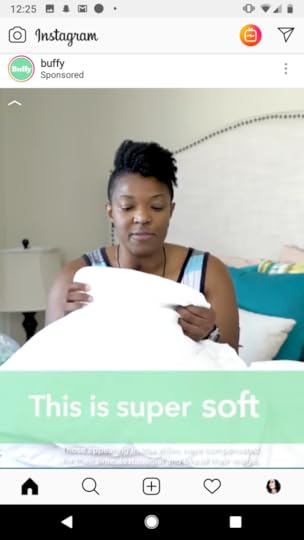
Buffy promotes its comforters using social proof as its primary strategy in this particular ad. The video shows a customer’s review of a Buffy comforter, using a light green bar at the bottom behind the captions to match the brand’s color scheme, which demonstrates good branding as well. In the video, the customer is using the product while she praises it, giving it her stamp of approval. The caption includes a quote by the customer and five stars. This strategy helps build trust: you almost feel like it’s an organic post by a regular user rather than a sponsored ad. In addition, the “learn more” call-to-action allows you to engage with the post, driving traffic to the Buffy website to buy this highly praised comforter.
17. Payoff

Payoff is a loan service that helps people pay off debt. In this ad, Payoff elicits emotion, employs good branding, and uses a little bit of social proof. First, the “Bye Debt” gives you a sense of relief. Finally, you’ve received the answer to your money problems. Second, we see good branding with the open laptop showing Payoff in action and the use of the brand color, pink, with the “mearn more” call-to-action.
Finally, we see the social proof in the caption, where Payoff points out its recognition by prominent entities like Credit Karma, Forbes, Wall Street Journal, Glamour, and Yahoo, helping you see how trustworthy the company must be.
18. Waking Beauty
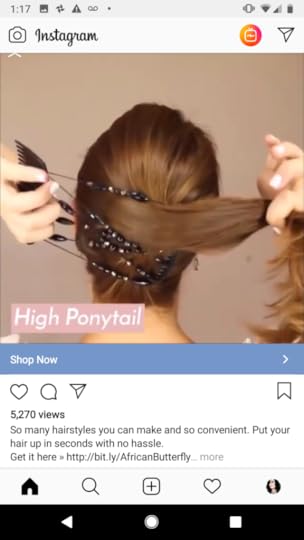
Waking Beauty, a company that sells hair and skin products, uses a tutorial video to both educate and stun its audience. The video shows all the various ways you can use a Waking Beauty hair comb to make stunning hairstyles. It makes you want to try the product. To drive traffic to its website, Waking Beauty also includes a “shop now” call to action.
19. Sleep Number
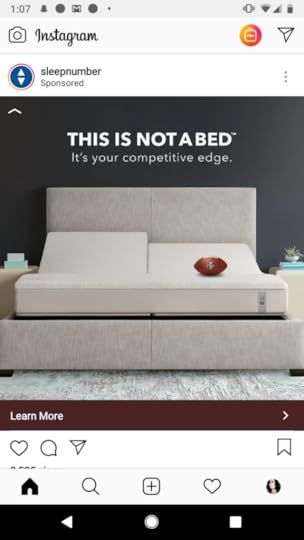
Relevance and social proof are key in this Sleep Number ad. With football season well underway, Sleep Number ties it together with the promotion of its bed, using a football animation bouncing on the bed and referring to the brand’s partnership with the NFL in providing better sleep. The ad then appeals to the competitive side of football fans with the line “This is not a bed: It’s your competitive edge.” If you are a football fan, you’re likely tempted to at least tap the “Learn More” call to action to browse Sleep Number’s bed selection on its website.
20. Wayfair
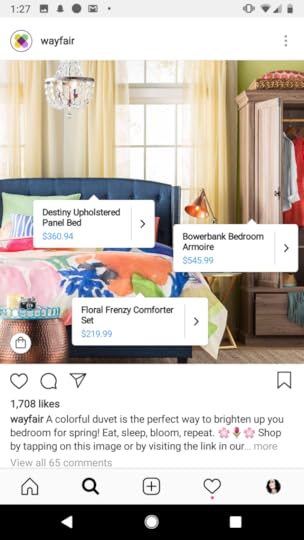
Wayfair, an online store for furniture and other household necessities and decor, gives us another example of Shoppable tags in action. The company uses a high-quality photo of a nicely decorated bedroom to feature its products in an appealing fashion. You can then tap on items in the image to see how much they cost and on the arrow to learn more about the product you’re interested in. This strategy is an effective way to capitalize on shoppers’ household tastes at their highest point of interest to get them to visit Wayfair’s website and easily buy the products in the image in a seamless experience.
The Next Step
Think you have a better feel for what a good Instagram ad can look like? Jot down any ideas these examples spark in the creative nook of your brain and get to work. Your ad could be the next one to be listed among the greats.
Written by Anna Hubbel, writer at AdvertiseMint, Facebook advertising company
The post 20 Instagram Ads That Rock and Why appeared first on AdvertiseMint.
October 24, 2018
Messenger 4 Is Coming Soon to Smartphones Near You
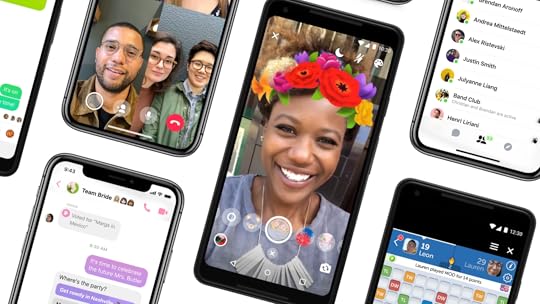 October 24, 2018
October 24, 2018Anne Felicitas, editor at AdvertiseMint, Facebook ad agency
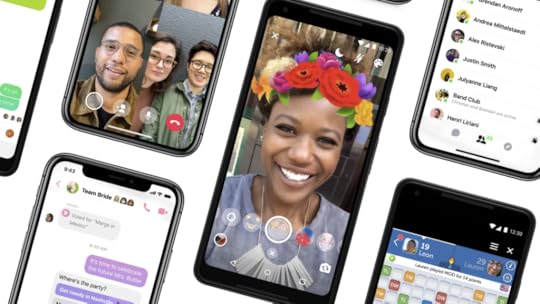 Photo courtesy of messengernews.fb.com
Photo courtesy of messengernews.fb.comIf it ain’t broke, don’t fix it—right? Not for Facebook.
In a status update, Facebook’s head of Messenger David Marcus announced a new and improved Messenger: Messenger 4. Although many may consider Messenger’s design and functionality fine as it is, the messaging app released updates that simplify the app and make it appealing to younger users (cough—Snapchat users—cough).
“Really proud of the Messenger team for releasing the new simplified, streamlined, better-in-all-ways Messenger,” said Marcus in his Facebook status update.
The new Messenger, according to the Messenger News post, has reduced number of tabs. Rather than nine, Messenger now has three. One for conversations, one for contact lists, and one for groups.
The first tab, dubbed Chats, contains one-on-one conversations and group chats with friends. The second, People, contains a friends list that users can scroll through to see who’s online to chat (you up?). The third—given a familiar name that recalls a feature of a rival app (Snapchat)—Discover, contains business accounts, games, news, and more.
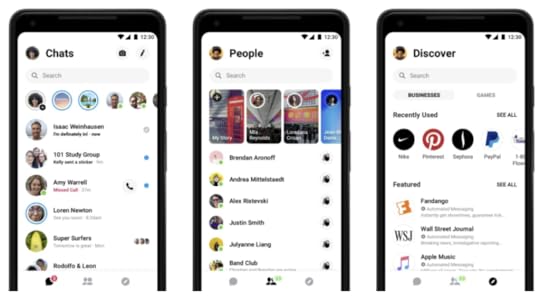 Photo courtesy of messengernews.fb.com
Photo courtesy of messengernews.fb.comWith the functional updates come the impractical, meant to excite younger users. Located at the top-right corner of the screen, Messenger 4 has a camera for selfies, likely aimed at attracting Instagram and Snapchat fans. It also has a more colorful design. The app has a new color gradient feature that allows users to change the color of their message bubbles “to reflect [their] mood and topic of conversation,” bubbles that change hues as they scroll.
While some Messenger fans approve of the changes (Looking forward to trying this out! So much fun here), some don’t.
“Have you considered not forcing a list of stories at the top that I’ve never used and didn’t ask for?” commented one displeased Richard Lawler, Engadget’s senior news editor.
The Messenger 4 updates, rolling out now, will come in phases. The first phase includes the aforementioned features, and the second phase will include dark mode and a new interface that reduces screen glare. Maybe Lawler will find the second phase’s update more appealing.
Written by Anne Felicitas, editor at AdvertiseMint, Facebook ad agency
The post Messenger 4 Is Coming Soon to Smartphones Near You appeared first on AdvertiseMint.
October 23, 2018
Deleting Your Facebook Account: What You Need to Know
 October 23, 2018
October 23, 2018Anne Felicitas, editor at AdvertiseMint, Facebook advertising company
 Thought Catalog / Unsplash
Thought Catalog / UnsplashYou face a tough decision: should you delete your Facebook account?
As torn as you are, know you are not alone. A Google search for the words “Facebook account” tellingly show a new trend: two of the top three search results are articles that teach people how to permanently delete Facebook from their lives.
 Search yields articles on how to delete Facebook.
Search yields articles on how to delete Facebook.You, and the many others on the Internet, have good reasons for leaving. Why stay when, in the past two years alone, Facebook allowed politically divisive Russian ads and fake news to proliferate on its platform. Why place your trust in a company that concealed the data breach of 87 million users. Just when the wounds from those betrayals are healing, you learn of a Facebook security issue that exposed user accounts to hackers. You want to leave, and that’s not surprising.
You might, however, have second thoughts. A loyal Facebook user for many years, you may mourn the loss of the memories you built: your pictures that detail your life from high school to present day, your connections, your witty status updates, the lovely birthday greetings friends posted on your timeline throughout the years. When your Facebook account is gone, is it gone for good?
Deleting Your Account: The Aftermath
According to a post in Facebook’s help center, you can’t retrieve a deleted account, and when your deleted account goes to the social media afterlife, your profile, photos, posts, videos, and everything you posted on Facebook will go with it. And like your deleted account, you can’t retrieve anything you posted or added on Facebook unless you download your data and archives before deleting your account.
Of course, you may no longer care about the memories you built on Facebook. To you, Facebook is just another MySpace, and you’re ready to move on to another social media app. Unfortunately, moving on may be more difficult than you expected. After deleting your account, you can’t use Facebook Messenger and access the apps for which you use your Facebook login, like Spotify, Pinterest, and Instagram. For the latter issue, you would need to contact the apps and websites to recover your accounts. Deleting your Facebook account may be a bigger hassle than you expected, especially when so much of your online activities are intertwined.
Deactivation, a Less Drastic Solution
If you want a less drastic solution (perhaps you want a temporary break rather than a permanent divorce from Facebook), you can, instead, deactivate your account. Unlike deletion, when you deactivate your account, you won’t lose your photos and videos; you can still use Messenger; you can still use your Facebook login to access your connected apps, and you can still return any time you want. Although you are no longer visible to your Facebook friends (people won’t see and can’t visit your profile), you can still connect with those friends on Messenger. Deactivation allows you to take all the time you need and return whenever you’re ready, whenever you find a reason to keep your Facebook account.
You Deleted Your Account. Now What?
 Radu Florin / Unsplash
Radu Florin / UnsplashAs torn as you are, you weighed your options and deleted your Facebook account. Sure, you may have abandoned the platform on which you built memories and gained friends throughout the years, but after recent events, you can no longer support the company that failed its users too many times—it’s understandable.
But if you find yourself missing Facebook, if you suddenly have the desire to restore your account, there is still hope. Facebook gives you 30 days to finalize your decision, in the event that you begin to have second thoughts. If you log back into your account in less than 30 days, you can still save it. Wait longer than 30 days, and your account is lost forever.
When you delete your Facebook account, is it gone for good? Yes, unless you meet the 30-day grace period. Facebook wouldn’t let you go so easily.
Written by Anne Felicitas, editor at AdvertiseMint, Facebook advertising company.
The post Deleting Your Facebook Account: What You Need to Know appeared first on AdvertiseMint.
October 22, 2018
10 Metrics Every Email Marketer Needs to Track
 October 22, 2018
October 22, 2018Guest Post

Email marketing may seem simple, but there are a lot of components that contribute to an optimized campaign. I could discuss common mistakes, show you shining examples of campaigns that work, or even get into detail with optimization, but none of that makes any difference if you can’t determine whether or not your email marketing efforts are succeeding or failing.
Here, I will briefly discuss the ways you can analyze and understand your email campaign results, going over metrics such as bounce rates, unsubscribers, and click-through rates. Before you can measure your results, you need something to measure: a goal at the end of the marketing tunnel.
The Goal-Oriented Email Campaign
Typical email marketing goals include
Converting leads to customers
Increasing your subscriber database
Generating leads
Recovering lost customers
Increasing engagement
You can choose any—or all—of these goals. Choosing a goal gives you an aim for your campaign and helps you target, optimize, and focus your efforts to be cost- and time-effective. Whichever goals you choose, measuring your results will give you insight into the effectiveness of your campaign as it relates to that goal.
Metrics for the Win
Now that you’ve set goals, optimized your emails for the specifics, and run your campaign, it’s time to see if your efforts are working. Email marketing, contrary to some opinions, is not a set-it-and-forget-it strategy. You have to constantly watch for changes in trends, audience opinions, and markets to keep your campaigns producing results. The best way to do that is by measuring email marketing metrics.
While there are many metrics to measure email effectiveness, there are a handful that all marketers should heed, regardless of goals, metrics such as email open rate and click-through rate. If people aren’t opening your emails or not clicking the links inside, your sales funnel has a serious problem.
Bounce rate, unsubscribes, and spam rate are the other metrics you should monitor because they help keep your list clean of useless addresses and uncover problems in your campaign that could be causing dissatisfaction with your email recipients. Measuring metrics like sales, shares, and subscribes are important hallmarks for proper campaign management, allowing you to make adjustments on the fly.
Tracking Metrics: An Essential Email Marketing Skill
To determine whether your email marketing campaigns are effective, you must first understand the metrics analytical reports show you. Otherwise, you won’t be able to strategize and optimize. Below is an infographic that gives you the metrics you need to understand to effectively run an email campaign. Keep this infographic by your side or memorize it by heart—do whatever it takes to know these metrics like the back of your hand.

This infographic first appeared on www.campaignmonitor.com
The post 10 Metrics Every Email Marketer Needs to Track appeared first on AdvertiseMint.
October 19, 2018
Facebook Developing Video Polls, 3D Ads, and More, Says Partner at Event
 October 19, 2018
October 19, 2018Anne Felicitas, editor at AdvertiseMint, Facebook ads company

Advertisers braved the 405 traffic to attend Facebook’s event yesterday evening. Inside Facebook’s Playa Vista headquarters, a small crowd gathered to hear three Facebook marketing partners discuss creative, ad buying, and ad delivery strategies. The crowd didn’t know that during the two-hour talk, one partner would let slip exciting features Facebook engineers are currently developing.
Video polling many no longer be unique to Instagram Stories, the partner hinted during the event. Coming to users in 2019, video polling will appear in Facebook feeds. Much like the Instagram Stories version, which it was modeled after, video polling allows users to add polls to their videos. Each poll choice, once clicked, leads viewers to different pieces of content.
Recently, Facebook announced that it is rolling out 3D images to News Feeds, causing some to suspect that it will eventually include 3D ads to its offerings. One marketing partner expressed the same suspicion at yesterday’s event. According to the partner, Facebook will likely offer 3D ads to advertisers, although the partner was not sure when that will happen.
The marketing partner also hinted at the possible development of two coveted ad products: custom copy by platform and a transparency tool for connected TV ads. If developed, custom copy by platform will allow advertisers to use different copies for different placements. Since a custom media tool is already available, a custom copy by platform tool is not such a far-fetched idea. If Facebook’s engineers also develop a transparency tool for connected TVs, advertisers will know where their ads appear when placed on connected TV. Currently, advertisers can’t see where their connected TV ads appear.
Although video polling will roll out to users next year, the other features won’t make an appearance any time soon, if at all—don’t set your hopes too high.
Written by Anne Felicitas, editor at AdvertiseMint, Facebook ads company
The post Facebook Developing Video Polls, 3D Ads, and More, Says Partner at Event appeared first on AdvertiseMint.
7 Secrets for Controlling Your Facebook Groups
 October 19, 2018
October 19, 2018Anna Hubbel, writer at AdvertiseMint, Facebook ads company
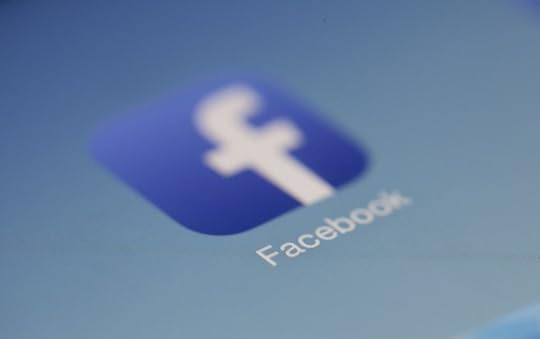
Just when I think I’ve fully mastered Facebook, I learn something new. Over the past year, I’ve tallied up the number of Facebook groups I’m a member of, so I decided to explore ways to make them more manageable on my smartphone. As it turns out, there are several tidbits of tech-savvy know-how that give me much more control over my groups than I thought possible. Using the Facebook app on my smartphone, I learned the following seven Facebook group secrets:
How to keep my groups organized
How to add a group to my favorites
How to customize my group notification settings
How to view additional info about my group
How to add a group to my phone’s home screen
How to create a group based on friend categories
How to discover new groups by category
In this article, I will detail the steps for each secret so that you too can gain control over your Facebook groups.
1. Keeping My Groups Organized
Step 1: Click on the Facebook menu at the top-right corner of your screen.
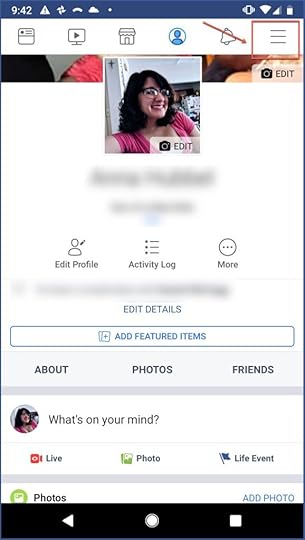
Step 2: Select “Groups.”
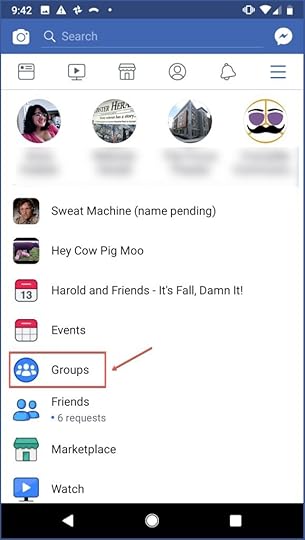
Step 3: Select the “Sort” dropdown menu above your groups.
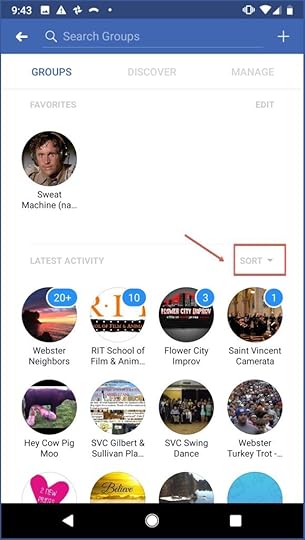
Step 4: Choose which organizational option you want. You can choose to organize your groups alphabetically, by latest activity, or recently visited.
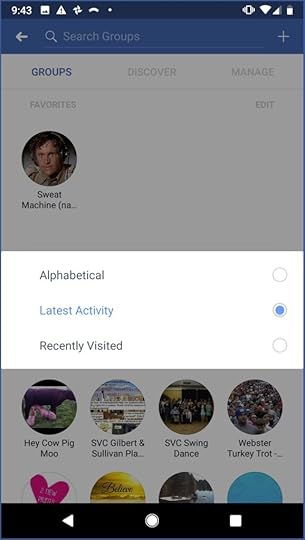
2. Adding a Group to My Favorites
Step 1: Go to your Facebook menu at the top-right corner of your screen.

Step 2: Select “Groups.”
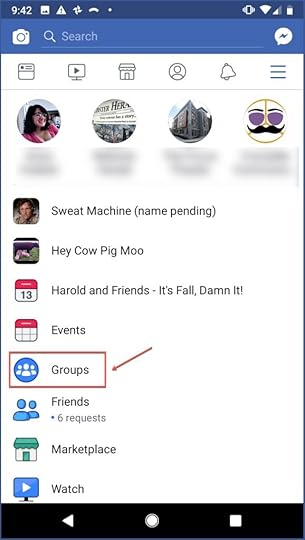
Step 3: Select the group you want to create a shortcut for.
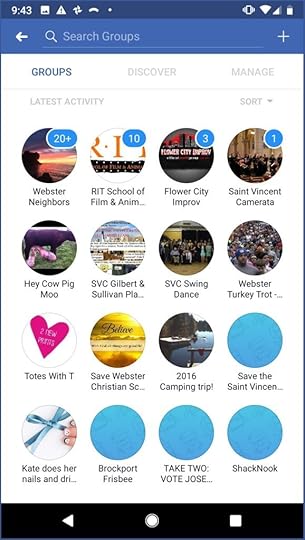
Step 4: Under the group’s cover photo, select the menu arrow at the right of the screen.
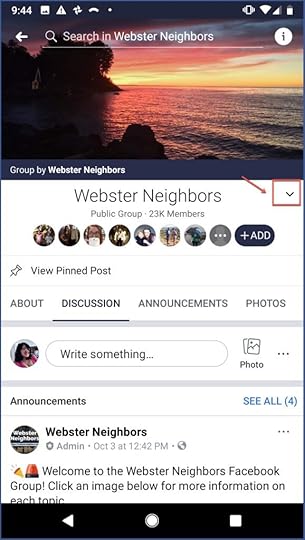
Step 5: Select “Add to Favorites.”
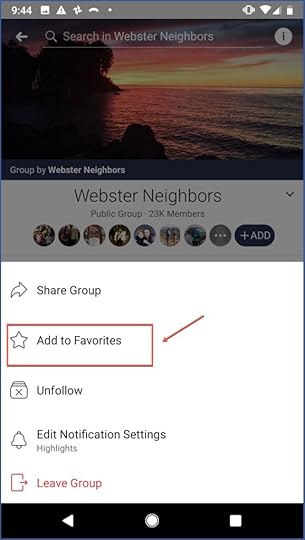
Step 6: Navigate back to “Groups.” You should see the group now listed at the top under “Favorites.”
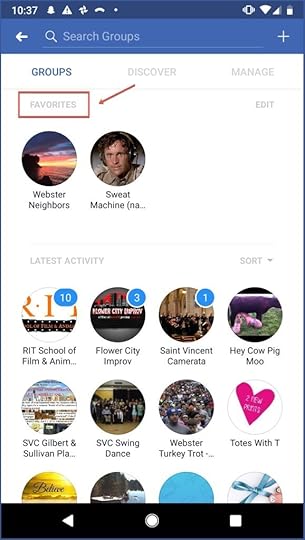
3. Customizing My Notification Settings
Step 1: Navigate to your Facebook menu at the top-right corner of your screen.
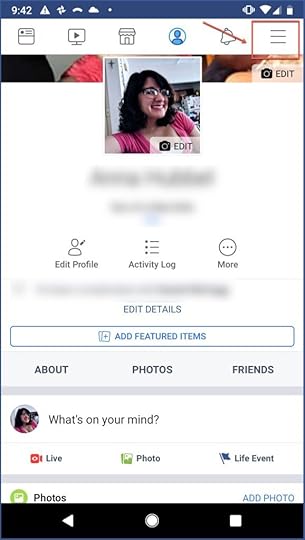
Step 2: Select “Groups.”
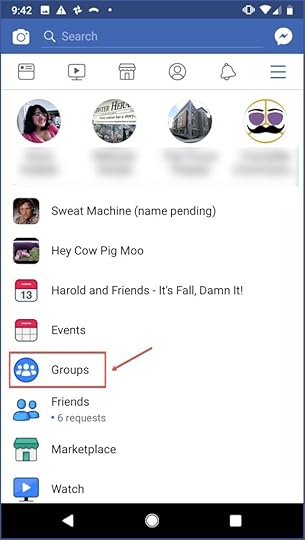
Step 3: Select the group you want to edit notifications for.
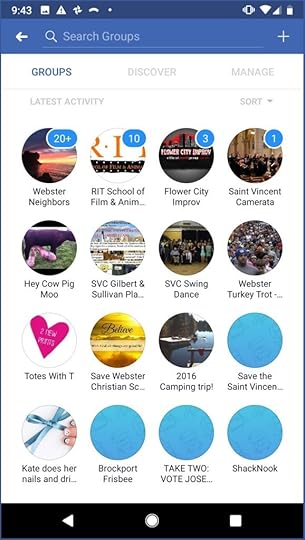
Step 4: Under the group’s cover photo, select the menu arrow at the right of the screen.
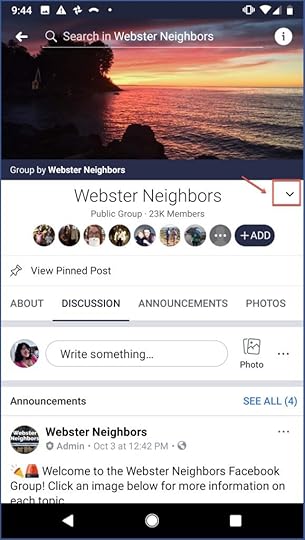
Step 5: Select “Edit Notification Settings.”

Step 6: You can now edit which actions in the group you get notified about. For instance, you can choose to only get notified whenever one of your friends posts in the group or you can choose to be notified about all group posts.
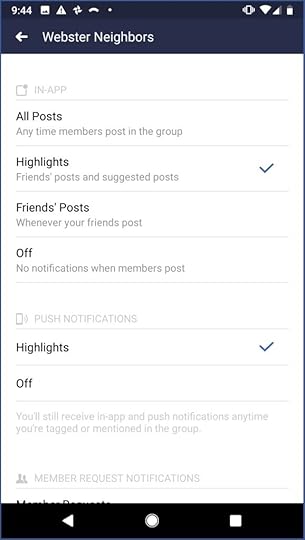
4. Viewing Additional Information about My Group
Step 1: Navigate to the group page and select the “i” icon at the top right of the screen.
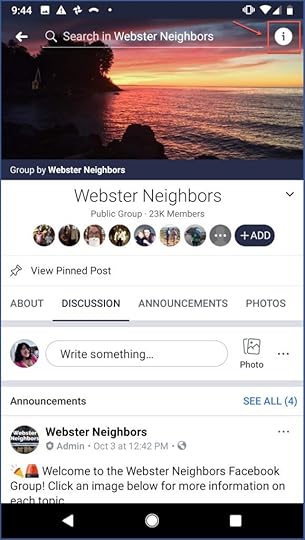
Step 2: See the group description at the top, the number of members in the group, group events, and more.
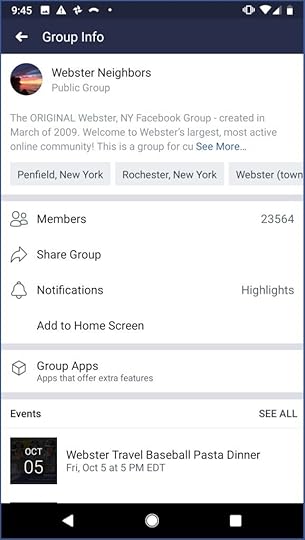
5. Adding a Group to My Home Screen
Step 1: Navigate to the group page and select the “i” icon at the top right of the screen.
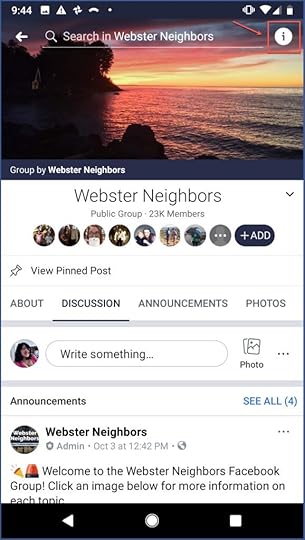
Step 2: Select “Add to Home Screen.”
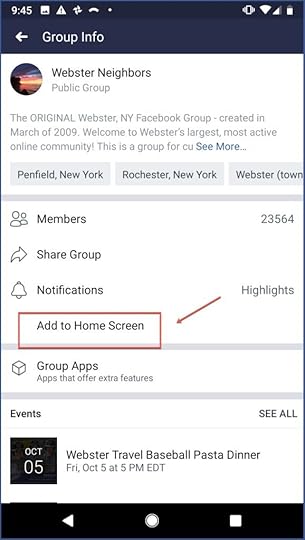
Step 3: Either press and hold the group icon to add it to your phone’s home screen manually or select “Add automatically.”

Step 4: Navigate to your home screen to see your group and select it whenever you want to visit your group page.
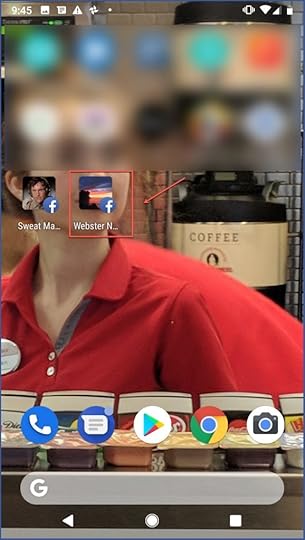
6. Creating a Group Based on Friend Categories
Step 1: Navigate to your Facebook menu at the top-right corner of your screen.
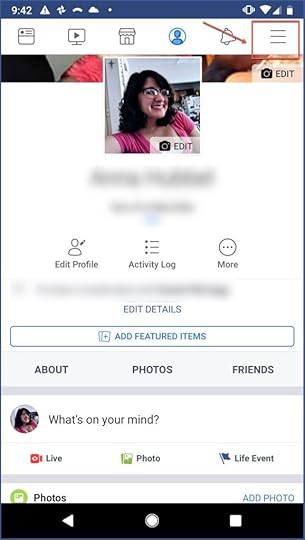
Step 2: Select “Groups.”
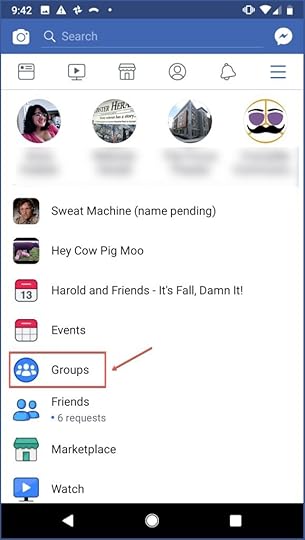
Step 3: Select the “Manage” tab.
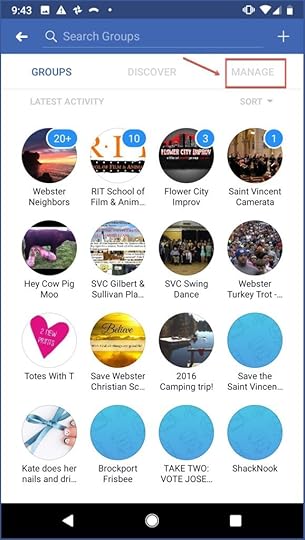
Step 4: Under “More Ways to Create,” browse the various types of groups Facebook suggests based on your friends. For example, you can create a family group or a group based on friends who all like the same page.

7. Discovering New Groups by Category
Step 1: Navigate to your Facebook menu at the top-right corner of your screen.
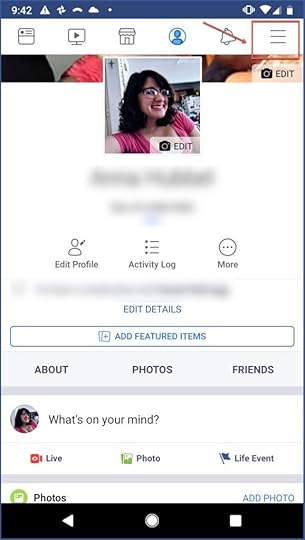
Step 2: Select “Groups.”

Step 3: Select the “Discover” tab.
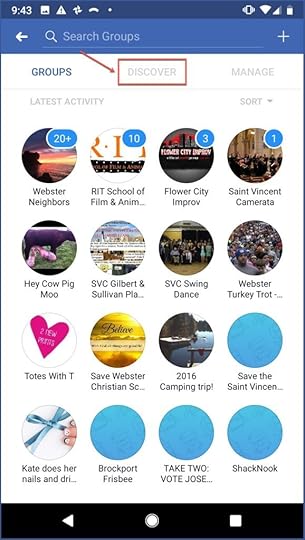
Step 4: Select “See All Categories.”
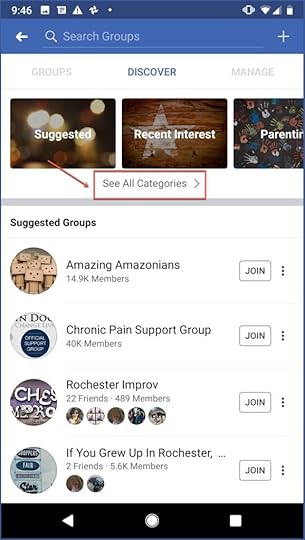
Step 5: Choose the categories that interest you to search for related groups.
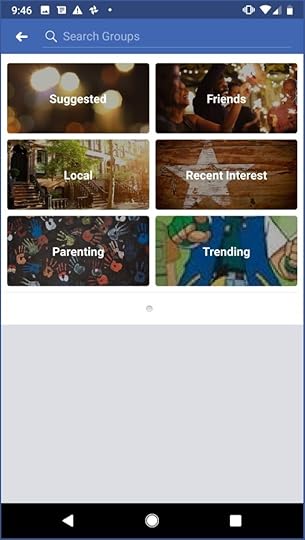
Now that you know all these juicy group secrets, you can be more proficient, with an overall better Facebook experience. You can keep your groups organized and prioritized, as well as relevant.
If you’re on a tech-savvy high, and you want to learn how to have even more control over your Facebook account, learn how to protect your Facebook data from apps.
Written by Anna Hubbel, writer at AdvertiseMint, Facebook ads company
The post 7 Secrets for Controlling Your Facebook Groups appeared first on AdvertiseMint.
October 18, 2018
Snapchat in September: User Trends
 October 18, 2018
October 18, 2018Anna Hubbel, writer at AdvertiseMint, Facebook advertising company
 Alisa Anton/Unsplash
Alisa Anton/UnsplashSnapchatters are welcoming fall with wide open arms, and it’s showing. Snap recently shared a September update on its business blog, identifying user trends on the app throughout the month, and the findings indicate a head-on theme of autumn and Halloween spirit. By looking at the common trends of the average Snapchatter, you can better understand users and their interests. You can also ensure your campaigns are more relevant, hopefully leading to more engagement and conversions.
But before you create your fall-themed Snapchat ads for this season, you should know the specific trends that were hot in September to better inform your campaign. Specifically, you should understand the trends in the following categories:
Global trending topics
US trending topics
Germany trending topics
US trending entertainment
US trending celebrities
US trending slang
Topics That Were Trending Globally
There were several topics trending across the globe in September:
The horror film The Nun was at the top of the charts in France, Kuwait, Netherlands, Sweden, and the United Arab Emirates.
Snapchatters throughout the western hemisphere grieved in light of Mac Miller’s death.
Australia honored Father’s Day.
Germany welcomed the start of Oktoberfest.
India celebrated the festival of Ganesh Chaturthi.
Saudi Arabia celebrated its 88th National Day.
Topics That Were Trending in the US

Riley McCullough/Unsplash
US Snapchatters were enamored with very exciting topics:
The Canelo Álvarez vs. Gennady Golovkin “GGG” boxing match
The new Apple iPhone
Lil Wayne’s new album “Tha Carter V”
Six Flags Fright Fest
Sunday football
Homecoming
Topics That Were Trending in Germany
While Germany shared many of the same trends as other parts of the globe, the country had some unique trends of its own:
Oktoberfest
The Nun
The new FIFA 19 video game
Champions League
Love Island
Back to school
The iPhone XS
Trending Entertainment in the US
Entertainment trends in the US throughout September included:
The Canelo Álvarez vs. Gennady Golovkin “GGG” boxing match
White Boy Rick (movie)
Nappily Ever After (movie)
Sierra Burgess Is a Loser (movie)
The return of American Horror Story (TV show)
Spider-Man (video game)
NBA 2K19 (video game)
The Predator (movie)
The Nun (movie)
A Simple Favor (movie)
Trending Celebrities in the US
 Alex Alexander/Unsplash
Alex Alexander/UnsplashCelebrities also had the attention of US Snapchatters, primarily rap celebrities:
Mac Miller
The release of Lil Wayne’s “Tha Carter V”
The release of Lil Uzi Vert’s “New Patek,”
Kid Ink’s “Big Deal” video
“Falling Down” by the late Lil Peep and XXXTentacion
Trending Slang in the US
The most popular slang US Snapchatters used in September included:
“Spoopy” (both funny and spooky)
“Bet” (the equivalent of “for sure” or “okay”)
“Cuffin’” (in a relationship)
“Darty” (an abbreviation for “daytime party”)
“Slat” (a fun situation)
Use Trends to Inform Ad Campaigns
 Rawpixel/Unsplash
Rawpixel/UnsplashSo what can you do with this information? A couple options come to mind. One, you find a way to incorporate these themes into your campaigns for October. For example, you can toss the word “Spoopy” somewhere in your ad creative for fall promotions. Another option is to use the information to make predictions about October trends and capitalize on it. For example, promote your horror film on Snapchat to tap into those thrill-seeking users leading up to Halloween.
With the holidays fast approaching, you should, if you haven’t already, use Snapchat’s latest tools and updates. The platform recently announced new enhancements for Shoppable Ads, an Amazon product search tool for its camera, and major updates to its Partnership Program, so clearly, Snap is already setting up new ways for advertisers to reach users. Tap into the fuzzy feelings of autumn, but keep in mind that Thanksgiving and the rest are not far behind.
By keeping up with what’s trending and taking advantage of the Snapchat advertising tools available, you will be sure to walk away from the holidays jollier than Saint Nick himself. So let’s get this darty started!
Written by Anna Hubbel, writer at AdvertiseMint, Facebook advertising company
The post Snapchat in September: User Trends appeared first on AdvertiseMint.
October 17, 2018
13 Examples of Amazon Ads That Rock
 October 17, 2018
October 17, 2018Anna Hubbel, writer at AdvertiseMint, Facebook ad agency

If you’re like the many advertisers flocking to Amazon, especially for the upcoming holiday season, you are likely still learning the secrets of marketing on the platform. How do you stand out when so many other businesses around the world are competing for the same benefits of the e-commerce site?
As dismaying as it may seem, it is not impossible to succeed on Amazon. It is quickly becoming one of the biggest advertising platforms, moving up to third place behind Facebook and Google. There’s still a lot of mystery about mastering Amazon advertising, so it helps to look at what’s working for other brands that use the platform.
There are many elements that make a good Amazon ad. In addition to choosing the right type of ad format that fits your goals, you need to incorporate relevant and high-quality images, detailed descriptions, and unique keywords. By identifying the elements of 13 Amazon ads that do it right, you can go forth and produce your own rockin’ Amazon ads.
1. Fujifilm Polaroid Camera
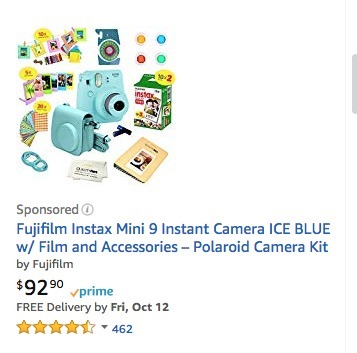
It identifies the brand Fujifilm in the description while identifying the product as a Polaroid camera.
It includes the product type in the title (Instax Mini 9 Instant Camera).
The description tells you what the purchase includes (camera, film, and accessories).
Each word in the description serves as a unique keyword.
The photo matches the description and shows all the included accessories.
The product has a good Amazon rating (4.5 stars from 462 reviews) that serves as social proof.
2. KLIQ UberTuner

It identifies the brand (KLIQ) and describes the item accurately: an instrument tuner.
It tells you what it does. (It’s a clip-on tuner for various instruments).
It includes other instruments it can be used for (guitar, bass, violin, and ukulele.).
Each word in the description serves as a unique keyword.
The photo is a close-up of the product.
The product has an excellent Amazon rating (4.5 from a whopping 2,619) that serves as social proof.
3. Charmin Toilet Paper

The logo appears three times, drilling the brand into your mind.
The description and photo accurately describe the item (toilet paper).
It offers the benefit of saving money: “Save Now on Toilet Paper.”
It features two products (ultra strong and ultra soft) so you have a selection to choose from.
The descriptions give sufficient details about each product: “Ultra Strong,” “Clean Touch,” “Family,” “Ultra Soft,” “Family Mega Roll.”
4. Samsung Powerbot

The brand name (Samsung) is in each product description.
The item is accurately described as a robotic vacuum.
It gives the benefit of working less when cleaning the house: “Save time and effort.”
It features three powerbot products so you have a selection to choose from.
The descriptions give sufficient details about each product (“Turbo,” “Pet Robot Vacuum”).
5. Swiffer WetJet Pad Refill
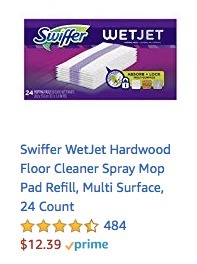
The Swiffer brand appears in the image and the description.
The description accurately describes the item as WetJet pad refills.
The description tells you what the product does (the pads are used with the Swiffer mop to clean hardwood floors and multi surfaces).
It includes specifics about the product (24 pieces, compatible with the Swiffer WetJet spray mop).
The photo matches the description and gives you a close-up of the product.
Each word in the description serves as a unique keyword.
The product has a good Amazon rating.
6. Puracy Natural All-Purpose Cleaner
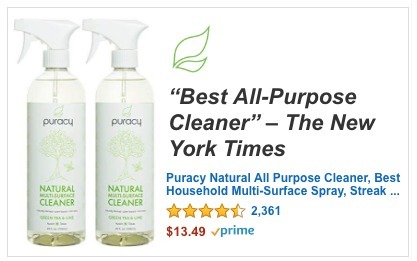
It clearly identifies the brand Puracy in the ad image and accurately describes the item as an all-purpose cleaner.
It tells you the product’s purpose: it cleans all types of household surfaces.
It includes specifics about the product (natural, spray, all purpose).
It features, in an attractive bold font, a review from The New York Times, functioning as powerful social proof.
The logo is clearly and visibly featured next to The New York Times review.
7. Vitafusion
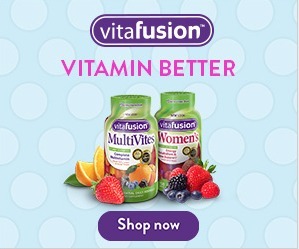
It clearly identifies the brand by including the Vitafusion logo in the image.
It accurately describes the item as vitamins.
It features bright colors that pop and that match the brand logo.
It includes images of fruit to associate the products with health and all-natural, delicious ingredients.
It has a clear call-to-action (“shop now”) that takes you to the brand’s Amazon storefront.
8. Well Hung Over in Vegas Kindle Book

The title description is the same as the book title, making it easy to identify.
The image is the book cover, matching the title description.
It includes a brief summary of the book in two, very succinct sentences (“What happens in Vegas doesn’t always stay in Vegas…”).
9. SUNPOW Travel Duffle Bag
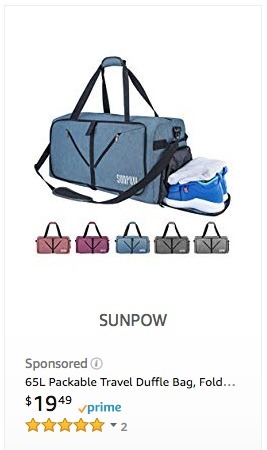
The image clearly features the brand (SUNPOW) in an isolated area that allows it to stand out from the product.
The product image and description shows what the item is (travel duffle bag).
It includes specifics about the product (65L, packable, travel, fold).
It includes multiple photos below the main photo to show you the different colors the product comes in.
10. Microsoft Surface Pro

It clearly features the Microsoft brand logo and what the item is (Surface Pro laptop).
It lures you with a product benefit: it’s “Ultra-light and versatile.”
It features three of the Surface Pro 6 products to give you a selection to choose from.
The photos for each featured product match the descriptions.
Each word in the descriptions serves as a unique keyword.
The descriptions give sufficient details about each product (“LGP-00001,” “Intel Core i5,” “8GB”).
11. Listerine

It clearly features the Listerine brand logo and what the items are (mouth cleaning products).
It lures you in with a benefit: the product will “Clean & Protect Virtually 100% of Your Mouth.”
It features three of its mouthwash products so you have a selection to choose from.
The photos for each featured product match the descriptions.
The descriptions give sufficient details about each product (“Antiseptic Mouthwash,” “Fresh Breath,” “Fluoride-Free”).
Each word in the description serves as a unique keyword.
Each featured product has a good Amazon rating.
12. Vera Wang Fragrance
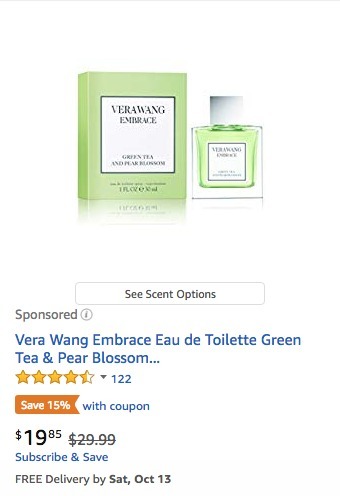
It clearly features the Vera Wang brand logo and shows you what the product is (perfume).
It includes specifics about the product: embrace contains green tea and pear blossom.
It gives you a reason to buy: get a 15 percent discount with a coupon
13. Tide Pods
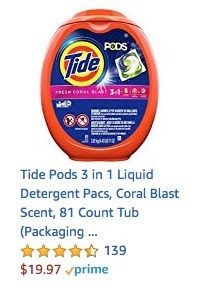
It clearly features the Tide logo and describes what the item is (detergent pods).
It tells you the number of pods the package contains (81 count).
It includes specifics about the product (coral blast scent, 3 in 1 liquid detergent pacs).
The photo matches the description and gives a close-up of the product.
Each word in the description serves as a unique keyword.
The product has a good Amazon rating.
There’s a lot of information to digest, but hopefully you’ve noticed these ads’ pattern of qualities that make them work. Keep a list of the qalities handy when putting together your own Amazon ads. It will help guide you through the creation process.
You are already well on your way to a successful holiday season on Amazon!
Written by Anna Hubbel, writer at AdvertiseMint, Facebook ad agency
The post 13 Examples of Amazon Ads That Rock appeared first on AdvertiseMint.
October 16, 2018
Will Facebook’s 3D Images Attract Younger Users?
 October 16, 2018
October 16, 2018Anne Felicitas, editor at AdvertiseMint, Facebook ad agency
 FOTOGRAFIA .GES/Unsplash
FOTOGRAFIA .GES/UnsplashIs Facebook for old people? As an avid Facebook user, I say no, but then again, I’m a Millennial whom many teens would likely consider old. (I considered 24 old when I was a teenager.) To settle that question, you only need to look at the data, which show Facebook attracts older people. According to Emarketer, everyone loves Facebook except teens.
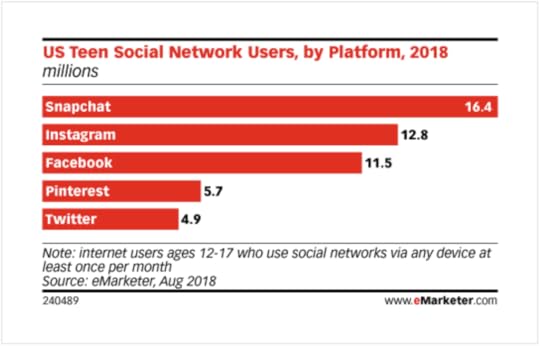
The market research company predicts Snapchat will continually add teens aged 12 to 17 to its user base while Facebook will continue to lose users from that age range. By 2022, Facebook will lose 2.2 million users of the ages 12 to 17.
If Facebook can’t attract younger users, it can’t retain a user base for the following years to come, and it will slowly lose relevance. Think about it this way. You may be in your 20s or 30s using Facebook religiously, but would you still spend as much time as you do now on Facebook when you’re 45 and married with kids? Likely not. Your busy schedule will not allow you.
Recently, Facebook announced a new feature that may attract younger users. 3D photos allow users to convert pictures into 3D images that people can tilt and rotate to view different sides and angles. The feature is not hard to use: take a portrait-mode photo using a compatible dual-lens smartphone, upload the image to your Facebook status, convert the image to 3D, and voila!
By rolling out 3D images, the social media company can place itself in line with the visually centered social media apps younger users love to use, Instagram and Snapchat. Because of 3D images’ highly interactive and unique format, it may encourage users to post more photos to the platform. Currently, Facebook centers on written content, such as links to articles and status updates. This is no surprise. Facebook originated as a platform where people can share their thoughts (aka their “status updates”). In fact, as soon as you log in to Facebook, the status feature appears, encouraging you to “Write something…” It wasn’t until two years ago when Facebook pushed for more visually captivating content, like videos.
Although 3D images can bring potential benefits to Facebook, like attracting younger people, retaining current users, and providing a more interactive experience, it won’t make an impact until it catches on. Facebook already has a cool 360 feature that few users seem to use and a Stories feature that failed miserably. Will 3D images be the one feature that will finally catch on? Or will it be another item added to the list of failures? We’ll see in a couple of weeks.
Written by Anne Felicitas, editor at AdvertiseMint, Facebook ad agency
The post Will Facebook’s 3D Images Attract Younger Users? appeared first on AdvertiseMint.



